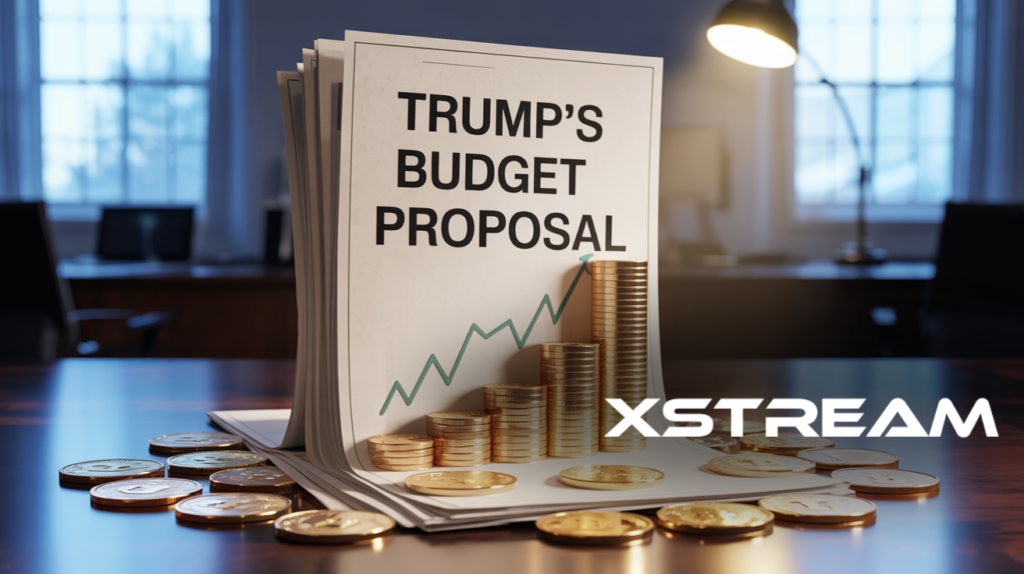In a bold move, President Donald Trump has unveiled his fiscal year 2026 budget proposal, which seeks to cut $163 billion in federal spending. This reduction is in line with the overarching goals of the Department of Government Efficiency (DOGE), led by Elon Musk and Vivek Ramaswamy, which aims to streamline government operations and eliminate inefficiencies within federal spending.
The proposal is expected to reshape how the U.S. government approaches its budget, focusing on eliminating unnecessary expenditures, scaling back non-defense discretionary programs, and shifting priorities in line with the administration’s broader economic vision.
Key Highlights of the Budget Proposal:
1. $163 Billion Reduction in Non-Defense Spending
The proposed budget outlines a $163 billion reduction in non-defense discretionary spending, targeting areas such as education, foreign aid, and environmental programs. These cuts represent a 22.6% reduction from current levels, signaling the administration’s commitment to reducing the size and scope of the federal government.
- Education: The Department of Education would see significant cuts, with proposed reductions targeting federal education funding and grants, redirecting resources to state-level initiatives.
- Foreign Aid: The budget also includes a substantial cut in foreign aid, particularly in development assistance, signaling a shift towards prioritizing domestic issues over international engagements.
- Environmental Programs: Environmental and climate-related programs would face cuts, with a focus on reducing spending on renewable energy initiatives and international climate commitments.
2. Increase in Defense and Homeland Security Spending
In stark contrast to the cuts in domestic programs, the proposal includes $1 trillion for defense spending, underscoring the administration’s emphasis on national security and military readiness. Additionally, funding for border security would increase by 64.9%, amounting to $175 billion, as part of the push to tighten control over immigration and national defense.
How This Mirrors the DOGE Plan:
The proposed budget aligns closely with the goals of DOGE (Department of Government Efficiency), an initiative spearheaded by Elon Musk and Vivek Ramaswamy. DOGE was designed to identify and eliminate government waste, streamline operations, and reduce spending in non-essential areas. Much like the president’s budget, DOGE has focused on trimming down unnecessary federal departments and programs while promoting efficiency.
- DOGE’s Influence: Although Musk has taken a step back from the department’s daily operations, DOGE’s approach is evident in the proposed budget cuts, particularly the push to reduce the size of government agencies. Since its inception, DOGE has claimed to have saved $160 billion through its efforts to eliminate inefficiencies, though some reports suggest that the actual savings could be significantly lower.
- Elimination of Wasteful Spending: The budget proposal reflects the philosophy promoted by DOGE—cutting what is perceived as wasteful and inefficient spending, while doubling down on areas like national defense and border security.

What This Means for the U.S. Economy and Government:
1. Impact on Essential Services
While the budget proposal is seen as a necessary step in addressing federal debt and fiscal responsibility, the cuts to programs such as education, foreign aid, and healthcare have sparked concerns about the potential impact on vulnerable communities. Critics argue that these reductions could undermine critical services, affecting everything from public education to international humanitarian aid.
2. Political and Legislative Challenges
The proposed budget faces an uphill battle in Congress, where lawmakers from both sides of the aisle have expressed concerns over the extent of the cuts. While the administration emphasizes the need for fiscal responsibility, the feasibility of these proposals remains uncertain, particularly when it comes to cutting programs that have widespread public support.
3. Potential for Economic Growth or Setback
The push to eliminate government inefficiencies could have both positive and negative effects on the U.S. economy. While some sectors might benefit from reduced government intervention and a more streamlined federal system, others may experience disruptions due to cuts in funding for essential services.
Looking Ahead:
As the budget proposal moves through Congress, all eyes will be on the debates and compromises that will shape the final version of the fiscal plan. The outcome will have lasting implications for the future of U.S. government spending, economic priorities, and the country’s overall approach to national defense and domestic welfare programs.
At XStream Elite, we’ll continue to track the latest developments related to the budget proposal, DOGE’s impact, and the broader economic policy landscape that could shape the future of U.S. governance.
📌 Stay informed with the latest policy news and economic analysis at XStream Elite.
— XStream Elite: Where Government Meets Efficiency.





